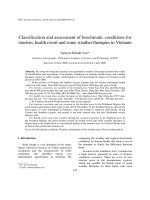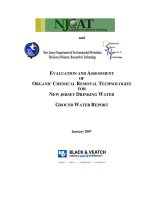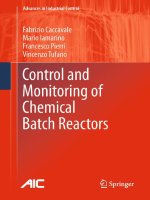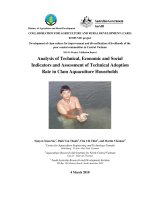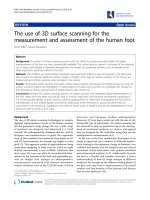Toxicity and Assessment of Chemical Mixtures
Bạn đang xem bản rút gọn của tài liệu. Xem và tải ngay bản đầy đủ của tài liệu tại đây (861.47 KB, 35 trang )
Toxicity and Assessment of
Chemical Mixtures
Monday, December 12 2011
Herman Autrup
1
Exposure is often to more than one
chemical, either through co-exposures
or exposure to mixtures
Each mixture of chemicals can have
unique toxicology
Few mixtures in the real world are
the same
Mixed exposures of chemicals and
non-chemical stressors
2
EFFECTS OF MIXTURES
3
Is there scientific evidence that when
organisms are exposed to a number
of different chemical substances,
that these substances may act jointly
in a way (addition, antagonism,
potentiation, synergies, etc.) that
affects the overall level of toxicity?
4
• Substances that are mixtures themselves (multi-
constituent substances, MCS; materials of
unknown or variable composition,
• Complex reaction products or biological
materials, UVCB)
• Products that contain more than one chemical
e.g. cosmetics, plant protection products;
• Chemicals jointly emitted from production sites,
during transport processes and consumption or
recycling processes;
• Several chemicals that might occur together in
environmental media (water, soil, air), food items,
biota and humans as a result of emission from
various sources and via multiple pathways.
EU DG SANCO DEFINITION (2011)
5
CUMULATIVE RISK
Cumulative risk means the risk of a common
toxic effect associated with concurrent
exposure by all relevant pathways and routes of
exposure to a group of chemicals that share a
common mechanism of toxicity
”Dose addition”
Cumulative risk means the combined risks
from aggregate exposures to multiple agents or
stressors (US EPA)
6
INTERACTION TERMINOLOGY
Type of
combined effect
Subtype Synonyms Effect observed
Non-interactive Simple similar
action
Additivity Dose addition
Simple dissimilar
action
Independent
action
Response addition
Interactive Potentiation Synergy Greater than dose
additive effect
Antagonism Less than dose
additive effects
7
Potentiation
Antagonism
POTENTIATION AND ANTAGONISM
8
INTERACTIONS - KINETIC
• Effects on absorption, distribution,
metabolism or excretion
• Induction of ”drug” metabolizing enzymes
• Reversible inhibition of ”drug”
metabolizing enzymes (competetive or non-
competitive)
• Suicide inhibition of enzymes
• Alteration in levels of co-factors
Do also apply to transporter proteins
9
INTERACTIONS - DYNAMIC
• Toxicodynamic
• Changes in structure or amount of target
•Up-regulation
• Down-regulation
• Competition
Alteration in level of cofactors/coenzymes
Effect on protective or repair systems
Non-specific mechanisms (cell death and damage
to membrane
)
10
INTERACTIONS
Synergism or potentiation
Could be relevant, even at exposures
below the respective NOAEL
Evidence is against this being common
when all of the compounds are below
their respective NOAELs
Antagonism (of toxicological effect)
Although this might occur is some cases,
there is no public health concern
11
SIMPLE SIMILAR ACTION
12
SIMPLE SIMILAR ACTION
Dose/concentration additivity
It is likely to occur when the chemicals in
the mixture act:
In the same way
By the same mechanism(s) – possibly at
the same macromolecule
Differ only in their potencies
13
SIMPLE SIMILAR ACTION
Effect is obtained by summing the doses of
the individual compounds, having adjusted
for differences in their potencies
Effecttotal = PotencyA x DoseA + PotencyB x
Dose B + + PotencyN x DoseN
14
POTENCY FACTORS
Toxicity equivalence factors (TEF)
Toxicity is calculated relative to an index
compound
The intake of residues is the multiplied
for each member of the common
mechanism group (CMG)
Thus the residue is ”normalised” in term
of the reference compound
Developed for risk assessment of
mixtures of structurally related dioxines
15
GROUPING COMPOUNDS
Common Mechanism Group
Group of compounds having the same toxicological
endpoint
Show dose addition
Easily defined with some groups, w.g.
Anticholinesterase OPs
More difficult with e.g. Endocrine disruptors, where
the effect may be similar but the mechanism different
Common assessment group
Group of compounds assumed to act by the same
mode of action on bais of preliminary evaluation
(e.g. Common target organ
16
CONCENTRATION ADDITION
17
SIMPLE DISSIMILAR ACTION
Results in response addition
It occurs when:
The modes, nature and/or sites of action
differ among the chemicals in the mixture
The constituents do not modulate the
effect of other constituents of the mixture
18
SIMPLE DISSIMILAR ACTION
19
DISSIMILAR ACTIONS
Christiansen S (2009) EHP 117: 1839-
20
PROBLEM FORMULATION
Is there environmental release
Are the identity of at least some of the
components known
Is there significant systemic exposure
Is there a pausible biological hypothesis to
consider the possibility of combined
effects/interactions
Basis to consider components in ”common
mechanism group
21
RISK ASSESSMENT PROCESS
22
TIERED APPROACH
Zero tier
Does exposure exceed relevant TTC
First tier (e.g. HI or PODI)
Do components act on the same tissue/cell
Same mode of action
Plausible hypothesis for interaction
Default factors to allow for potential synergy
Second tier
Mechanism of action
Relative potency
Third tier
PBPK/PD
Probabilistic assessment of exposure and/or hazard
23
HAZARD INDEX
Hazard index (HI) is the sum of the
exposures divided by their reference doses
HI = Exposure
1/ADI1 + Exposure2/ADI2 + +
Exposure
n/ADIn
HI inappropriate as it is based on the ADI,
which in turn is based upon critical NOELs
An uncertainty factor, which may be different
for the different compounds
24
HAZARD INDENTIFICATION
Determine chemical composition
Chemicals in a mixture may vary
Burning conditions in a wood stove
Predict toxicology
Test the toxicity of source-specific mixtures
in animal studies
Compare toxicity testing results among the various
mixtures to determine which component contribute
most to toxicity
25
